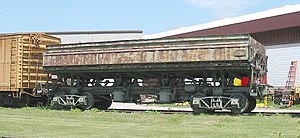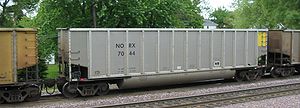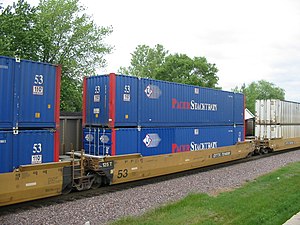Difference between revisions of "AY Honors/Model Railroad/Answer Key"
m (Transwiki:Covered hopper moved to AY Honor Model Railroad: transwiki import of w:Covered hopper) |
m (78 revisions from w:Gondola (rail)) |
||
| Line 1: | Line 1: | ||
| − | [[Image: | + | {{otheruses|Gondola (disambiguation)}} |
| − | [[ | + | [[Image:CW 5097 at Rochelle, IL, 20040718.jpg|thumb|300px|A railroad gondola seen at [[Rochelle, Illinois]].]] |
| + | In [[railroad terminology]], a '''gondola''' is an open-top type of [[rolling stock]] that is used for carrying loose bulk materials. Because of its low side walls, gondolas are used to carry either very dense material, such as [[steel]] plates or coils, or bulky items such as prefabricated pieces of [[rail track]]. | ||
| − | + | ==History== | |
| + | Before the opening of the [[Baltimore & Ohio Railroad]] and the [[Chesapeake & Ohio Canal]] in Harpers Ferry (West Virginia née Virginia), considerable amounts of [[coal]] were carried via the Potomac River. Since timber was an abundant resource, flat boats, called “[[gondolas]]” (a spoof on Venetian rowing boats), were constructed to navigate the "black diamonds" down river to markets around Washington, DC. There, both the boat and cargo were sold and the boatmen returned home by foot. The railroad cars first employed in the haulage of coal were thus named after these shallow-draft boats called “gondola cars.” | ||
| − | + | Early gondola cars typically had low sides. Their contents had to be shoveled out by hand and they took a long time to unload. In 1905, the [[Ralston Steel Car Company]] patented a flat bottom gondola with lever operated chutes that allowed the gondola to be unloaded automatically from the bottom. The chutes would direct the contents of the gondola to the sides. This coincided with the switch from wood to steel freight cars as the pulling force of locomotives tended to crush the older wood cars. | |
| − | + | ==Specialized car types== | |
| + | ===[[Coil car (rail)]]=== | ||
| + | ===Lorry===<!-- This section is linked from [[Railroad car]] --> | ||
| + | Or '''tippler''' (UK) | ||
| + | An open railroad car (gondola) with a tipping trough, often found in [[mining|mines]]. | ||
| − | + | ===[[Track ballast]] gondolas=== | |
| + | [[Image:Side dump gondola at NRM.jpg|thumb|A side-dump gondola on display at the [[National Railroad Museum]], [[Green Bay, Wisconsin]].]] | ||
| + | {{-}} | ||
| − | + | ==="Bathtub" gondolas=== | |
| + | [[Image:Bathtub gondola at Rochelle.jpg|right|thumbnail|A bathtub gondola passing through [[Rochelle, Illinois]], [[May 29]], [[2005]].]] | ||
| + | [[Image:PhosphateGon.JPG|left|thumbnail|[[CSX Transportation|CSXT]] 640006 awaits pickup at [[Edison Junction, Florida]]. Rotary gondolas such as these are used by CSXT to transport [[phosphate]] rock from the [[Bone Valley]] region to [[transloading]] facilities along [[Tampa Bay]].]] | ||
| + | In the second half of the 20th century, [[coal]] haulage shifted from open [[hopper car]]s to high-sided gondolas. Using a gondola, the railroads are able to haul a larger amount of coal per car since gondolas do not include the equipment needed for unloading. However, since these cars do not have hatches for unloading the products shipped in them, railroads must use [[rotary car dumper]]s (mechanisms that hold a car against a short section of track as the car and track are slowly rotated upside down to empty the car) or other means to empty them. The term "bathtub" refers to the shape of the car. | ||
| + | {{-}} | ||
| − | + | ===Container well cars=== | |
| + | [[Image:DTTX 724681 20050529 IL Rochelle.jpg|thumb|A portion of a 5-unit container car.]] | ||
| + | {{Main|Double-stack car}} | ||
| + | |||
| + | These specialized cars are designed to carry shipping [[container shipping|containers]], and in some ways resemble traditional gondolas, although their floors are usually partially open. A depressed center section provides a floor which is only inches above the rails. This stabilizes the container by lowering the [[center of gravity]], also allowing double-stacking, which would be impossible if the containers were placed on a [[flatcar]]. Single-unit well cars exist, but 3- and 5-car [[articulated]] sets are common. These reduce weight by reducing the number of [[bogie|trucks]] by nearly half, and also reduce the amount of slack in the train since there are fewer couplers. This protects the cargo by reducing the jolts that occur at starting and stopping caused by slack. | ||
| + | |||
| + | ===[[Modalohr]] road trailer carriers=== | ||
| + | Specialized [[railroad car]]s carrying [[Semi-trailer|road trailers]] and [[Tractor#Other types of tractors| road tractor]]s on a route from [[France]] to [[Italy]] and [[Luxembourg]] to [[Spain]] and vice versa. A deck between the [[bogie]]s (trucks) [[pivot]]s (swings) 30°, allowing the trailers to be loaded from the sides. For details see the official sites <ref>[http://www.lohr.fr/rail-route.htm Rail-route]</ref> or <ref>[http://www.modalohr.com Modalohr] | ||
| + | </ref> | ||
| + | |||
| + | ==References== | ||
| + | * Double Stack Intermodal Cars-Freight <ref>[http://www.curtis-engineering.com/fdoublestackinter.htm doublestackinter]</ref> | ||
| + | |||
| + | * Origins of name in railroad use <ref>[http://rlhs.org/rlhsnews/htms/nl27-2.htm Origin of name]</ref> | ||
| + | |||
| + | ==See also== | ||
| + | * [[Coil car (rail)]] | ||
| + | * [[Containerization]] | ||
| + | * [[Railgon Company]] | ||
| + | * [[Railroad car]] | ||
| + | |||
| + | == References == | ||
| + | <references/> | ||
| + | |||
| + | ==External links== | ||
| + | * [http://www.sdrm.org/roster/freight/gon72312/index.html Atchison, Topeka and Santa Fe Railway #72312] — photos and short history of an example of a typical steel, four-axle, solid bottom, fixed end, mill gondola. | ||
{{freight cars}} | {{freight cars}} | ||
| Line 18: | Line 55: | ||
[[Category:Freight equipment]] | [[Category:Freight equipment]] | ||
| − | + | [[cs:Modalohr]] | |
| − | + | [[de:Offener Güterwagen]] | |
| − | [[de:Offener Güterwagen | + | [[es:Vagón de piso bajo Modalohr]] |
| + | [[eo:Duonvagono]] | ||
| + | [[fr:Modalohr]] | ||
| + | [[ja:無蓋車]] | ||
| + | [[ru:Полувагон]] | ||
Revision as of 01:32, 1 December 2008
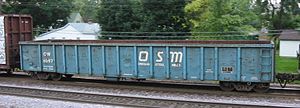
In railroad terminology, a gondola is an open-top type of rolling stock that is used for carrying loose bulk materials. Because of its low side walls, gondolas are used to carry either very dense material, such as steel plates or coils, or bulky items such as prefabricated pieces of rail track.
History
Before the opening of the Baltimore & Ohio Railroad and the Chesapeake & Ohio Canal in Harpers Ferry (West Virginia née Virginia), considerable amounts of coal were carried via the Potomac River. Since timber was an abundant resource, flat boats, called “gondolas” (a spoof on Venetian rowing boats), were constructed to navigate the "black diamonds" down river to markets around Washington, DC. There, both the boat and cargo were sold and the boatmen returned home by foot. The railroad cars first employed in the haulage of coal were thus named after these shallow-draft boats called “gondola cars.”
Early gondola cars typically had low sides. Their contents had to be shoveled out by hand and they took a long time to unload. In 1905, the Ralston Steel Car Company patented a flat bottom gondola with lever operated chutes that allowed the gondola to be unloaded automatically from the bottom. The chutes would direct the contents of the gondola to the sides. This coincided with the switch from wood to steel freight cars as the pulling force of locomotives tended to crush the older wood cars.
Specialized car types
Coil car (rail)
Lorry
Or tippler (UK) An open railroad car (gondola) with a tipping trough, often found in mines.
Track ballast gondolas
"Bathtub" gondolas
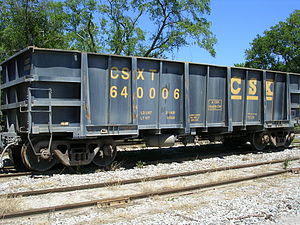
In the second half of the 20th century, coal haulage shifted from open hopper cars to high-sided gondolas. Using a gondola, the railroads are able to haul a larger amount of coal per car since gondolas do not include the equipment needed for unloading. However, since these cars do not have hatches for unloading the products shipped in them, railroads must use rotary car dumpers (mechanisms that hold a car against a short section of track as the car and track are slowly rotated upside down to empty the car) or other means to empty them. The term "bathtub" refers to the shape of the car.
Container well cars
These specialized cars are designed to carry shipping containers, and in some ways resemble traditional gondolas, although their floors are usually partially open. A depressed center section provides a floor which is only inches above the rails. This stabilizes the container by lowering the center of gravity, also allowing double-stacking, which would be impossible if the containers were placed on a flatcar. Single-unit well cars exist, but 3- and 5-car articulated sets are common. These reduce weight by reducing the number of trucks by nearly half, and also reduce the amount of slack in the train since there are fewer couplers. This protects the cargo by reducing the jolts that occur at starting and stopping caused by slack.
Modalohr road trailer carriers
Specialized railroad cars carrying road trailers and road tractors on a route from France to Italy and Luxembourg to Spain and vice versa. A deck between the bogies (trucks) pivots (swings) 30°, allowing the trailers to be loaded from the sides. For details see the official sites & or &
References
- Double Stack Intermodal Cars-Freight &
- Origins of name in railroad use &
See also
References
External links
- Atchison, Topeka and Santa Fe Railway #72312 — photos and short history of an example of a typical steel, four-axle, solid bottom, fixed end, mill gondola.
cs:Modalohr de:Offener Güterwagen es:Vagón de piso bajo Modalohr eo:Duonvagono fr:Modalohr ja:無蓋車 ru:Полувагон
